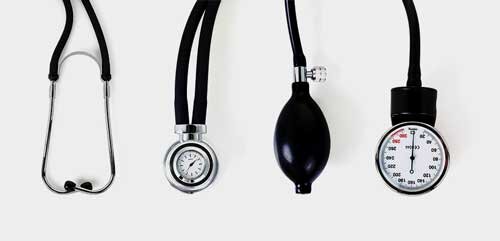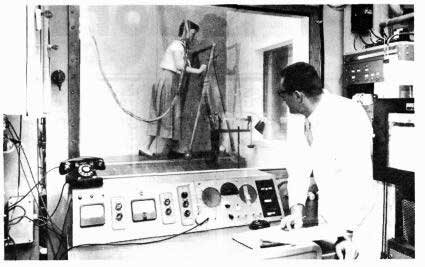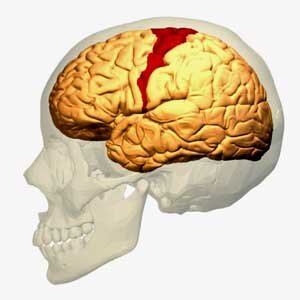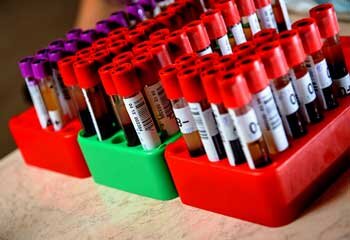A Former Doctor Goes Through the NIH's ME/CFS Intramural Study
Robert's Story
Robert, an MD, is board certified in internal medicine. After the worst flu-like illness he ever had, he ended up in the hospital. A regular exerciser prior to becoming ill, his legs were so weak that he could hardly walk afterwards.His path to a chronic fatigue syndrome (ME/CFS) diagnosis was rapid. Three months of testing left him no other conclusion - it was clear to him that he had ME/CFS. He was able to work on and off for a few years, but his health has deteriorated. He's been unable to work for the last three years. Thankfully, he had a wide array of doctor friends who knew him before he became ill and didn't encounter the skepticism and invalidation so commonly experienced in our community. He noted that our current medical culture doesn't offer much for the complex patient. Doctors are busy and often time-constrained and if you don’t fit into one of the medical pigeon-holes, they don't have much to offer.Rating his level of health on a scale of 1-10 at 2, he's one of the sickest, if not the sickest, ME/CFS patient to participate in the grueling two-part intramural study at the NIH. He was the first patient to go through the second phase of the Intramural trial which involved, among other things, the exercise study and an extended stay in a metabolic chamber.One theme - validation - cropped up several times during Robert's week long stay at the NIH hospital in Maryland. It was clearly apparent from the gestures of sympathy from the occupational therapist during a test to assess functioning. Given cards which identified an activity, Robert put them into two piles - activities he used to do and activities he still did. The occupational therapist - who has probably given this test hundreds if not thousands of times - registered dismay at the few cards left in his "still do" pile. Those few cards left made the extra level of devastation that ME/CFS is so good at causing clear. It's rare for people who are not elderly to be so sick.Given his abysmal level of functioning, Robert's willingness to participate in a study that Dr. Nath thought few might be willing to undergo was a real testament to the courage and determination that so impressed Dr. Nath. Despite Robert's low functional level (1-2 on a 10-point scale), he was disappointed that the NIH was not doing a two-day exercise test (!).The second part of the study is centered around the exercise stressor. Participants do cognitive testing, blood tests, the Seahorse mitochondrial test, a functional MRI and transcranial magnetic stimulation before and after the maximal exercise test. (The NIH communicated with the Workwell Foundation on doing the exercise test with ME/CFS patients).Exercise is finally getting its due in ME/CFS, and over the next couple of years several large studies should tell us much. With its extensive blood draws and millions of data points, Dr. Klimas's exercise studies have informed her models of ME/CFS and laid the foundations for her clinical trial. With help from the Solve ME/CFS Initiative, David Systrom has added gene expression to his already complex invasive cardiopulmonary exercise testing. Maureen Hanson has incorporated exercise into her large NIH Research Center studies at Cornell, as well. None of these studies, though, can match the sheer breadth of this NIH exercise study with its brain scans, lumbar punctures, Seahorse data, blood draws, etc..
Thankfully, he had a wide array of doctor friends who knew him before he became ill and didn't encounter the skepticism and invalidation so commonly experienced in our community. He noted that our current medical culture doesn't offer much for the complex patient. Doctors are busy and often time-constrained and if you don’t fit into one of the medical pigeon-holes, they don't have much to offer.Rating his level of health on a scale of 1-10 at 2, he's one of the sickest, if not the sickest, ME/CFS patient to participate in the grueling two-part intramural study at the NIH. He was the first patient to go through the second phase of the Intramural trial which involved, among other things, the exercise study and an extended stay in a metabolic chamber.One theme - validation - cropped up several times during Robert's week long stay at the NIH hospital in Maryland. It was clearly apparent from the gestures of sympathy from the occupational therapist during a test to assess functioning. Given cards which identified an activity, Robert put them into two piles - activities he used to do and activities he still did. The occupational therapist - who has probably given this test hundreds if not thousands of times - registered dismay at the few cards left in his "still do" pile. Those few cards left made the extra level of devastation that ME/CFS is so good at causing clear. It's rare for people who are not elderly to be so sick.Given his abysmal level of functioning, Robert's willingness to participate in a study that Dr. Nath thought few might be willing to undergo was a real testament to the courage and determination that so impressed Dr. Nath. Despite Robert's low functional level (1-2 on a 10-point scale), he was disappointed that the NIH was not doing a two-day exercise test (!).The second part of the study is centered around the exercise stressor. Participants do cognitive testing, blood tests, the Seahorse mitochondrial test, a functional MRI and transcranial magnetic stimulation before and after the maximal exercise test. (The NIH communicated with the Workwell Foundation on doing the exercise test with ME/CFS patients).Exercise is finally getting its due in ME/CFS, and over the next couple of years several large studies should tell us much. With its extensive blood draws and millions of data points, Dr. Klimas's exercise studies have informed her models of ME/CFS and laid the foundations for her clinical trial. With help from the Solve ME/CFS Initiative, David Systrom has added gene expression to his already complex invasive cardiopulmonary exercise testing. Maureen Hanson has incorporated exercise into her large NIH Research Center studies at Cornell, as well. None of these studies, though, can match the sheer breadth of this NIH exercise study with its brain scans, lumbar punctures, Seahorse data, blood draws, etc..
Metabolic Chamber
Robert spent about three days in the metabolic chamber - a sparse box containing a bed and a toilet that’s designed to produce precise measures of metabolic activity - before and after the exercise test. (I will expand on the metabolic chamber). He wore an EEG, blood pressure and Holter monitor, while in the chamber.Only thirty metabolic chambers exist in the world, and three of them are at the NIH. With 400 metabolic chamber studies underway every year, they're pretty much in use all the time. These airtight 11-by-11.5-foot rooms aren't much to look at or stay in: they come with a bed, an exercise bike, a toilet, and nothing else. Precisely measured meals are delivered through a small, air-locked opening in the wall. Metal pipes running along the ceiling that measure oxygen consumption and CO2 production allow researchers to precisely calculate an individual's metabolic rate. From the O2 and CO2 readings, researchers can calculate calories burned and what type of fuel (carbs/fats) was used to burn them. Urine is collected to assess protein oxidation.Metabolic chamber studies have demonstrated how flexible the body is with respect to metabolism. One reporter wrote, for instance, that they've debunked the idea that ketogenic diets (high-fat/low-carb) cause the body to burn more fat than high-carb diets.Energy is burned in our body in three ways. It turns out that simply staying alive is pretty energy intensive. Most of the calories we burn (65-80%) are used simply to keep our body running (basal metabolism). Digestion is no walk in the park either; digesting our food takes up about 10% of the calories we burn in a day, with physical activity accounting for the remainder (10-30%).If ME/CFS patients’ metabolic production and ability to produce energy is altered by exercise - as Workwell's and Dr. Keller's tests suggest it is - that will hopefully be picked up by the metabolic chamber.Robert noted that if they can pair the findings from the metabolic chamber - which is measuring the metabolic effects of exercise - with the Seahorse tests- which are measuring energy production on the cellular level, they may really be onto something.
Metal pipes running along the ceiling that measure oxygen consumption and CO2 production allow researchers to precisely calculate an individual's metabolic rate. From the O2 and CO2 readings, researchers can calculate calories burned and what type of fuel (carbs/fats) was used to burn them. Urine is collected to assess protein oxidation.Metabolic chamber studies have demonstrated how flexible the body is with respect to metabolism. One reporter wrote, for instance, that they've debunked the idea that ketogenic diets (high-fat/low-carb) cause the body to burn more fat than high-carb diets.Energy is burned in our body in three ways. It turns out that simply staying alive is pretty energy intensive. Most of the calories we burn (65-80%) are used simply to keep our body running (basal metabolism). Digestion is no walk in the park either; digesting our food takes up about 10% of the calories we burn in a day, with physical activity accounting for the remainder (10-30%).If ME/CFS patients’ metabolic production and ability to produce energy is altered by exercise - as Workwell's and Dr. Keller's tests suggest it is - that will hopefully be picked up by the metabolic chamber.Robert noted that if they can pair the findings from the metabolic chamber - which is measuring the metabolic effects of exercise - with the Seahorse tests- which are measuring energy production on the cellular level, they may really be onto something.
Brain Scan
The functional MRI - which Robert said was combined with a cognitive test - will assess the impact of exercise on a) cognitive functioning and b) brain functioning. A similar study by the CDC suggested that exercise negatively impacted both cognitive and brain functioning.People who do cognitive tests tend to improve the more they do them but not in this case - not in people with ME/CFS after exercise. Familiarity did not breed more competence. Despite doing the tests multiple times, the people with ME/CFS did worse and worse on them after exercise and the brain scans indicated why. Exercise had knocked out one area of the brain devoted to sustained attention causing the brain - in a mostly futile attempt to compensate - to increase activity in other parts of the brain (devoted to executive functioning).https://www.healthrising.org/blog/2014/11/10/chronic-fatigue-syndrome-brain-exercise-pretty-sight/The end result was that people with ME/CFS expended more effort during the cognitive test and yet did worse. By the end of the test they were making about double the errors of the healthy controls.
rTMS Test
 The repetitive transcranial magnetic stimulation (rTMS) test proved enormously interesting but physically draining. Robert reported that in a process that took hours, data from a previous fMRI was used map the exact location of his motor cortex in order to stimulate the muscles of his right hand/fingers. The goal was apparently to determine the speed at which the signal traveled from the brain to the muscle of his finger before and after exercise. A time delay after exercise would presumably indicate that exercise had interfered with the ability of the motor cortex to activate the muscles.A 2003 study, in fact, suggested that reduced muscle recruitment due to reduced motor cortex output was occurring in ME/CFS. The motor cortex, it turns out, plans our movements in advance. The study, titled “Deficit in motor performance correlates with changed corticospinal excitability in patients with chronic fatigue syndrome“ suggested that problems in the “motor preparatory areas of the brain” might be hampering physical movements in ME/CFS. It has never to my knowledge been followed up on.rTMS has relieved pain in fibromyalgia but it had the opposite effects in Robert. He wasn’t clear whether it was the effects of the rTMS or the rigors of setting up the test itself or both which triggered for him what turned out to be an extraordinary bout of PEM (post exertional malaise). The 2 hours it took - sitting up - to get the electrodes correct was in itself draining. (He suggested that they use a reclining chair for future patients if possible.)At the end of test Robert felt exhausted and experienced transient vertigo, auditory disturbance, headache and sensitivity to light and noises. His nurse was shocked at how poorly he looked. He'd mentioned the documentary Unrest to her the day before. After seeing the movie, she said she could better appreciate what he was going through. (Hopefully she knows that watching the film will get her continuing medical education (CME) credits)The rTMS test proved immediately much more exhausting than the exercise test, the effects of which took a day to kick in. The rTMS specialist/researcher was surprised at the effect the test had on Robert and its cause is unknown. Was it the long preparatory period or the activity of the rTMS machine on the muscle activation pathways or both? It'll be fascinating to see how other patients fare.Robert was also tested for small fiber neuropathy via skin biopsy, underwent a post exercise lumbar puncture and quadricep muscle biopsy. The possibility of integrating the brain scan, cerebral spinal fluid, Seahorse and metabolic chamber results after exercise - not to mention the immune tests - is an enticing one for sure.
The repetitive transcranial magnetic stimulation (rTMS) test proved enormously interesting but physically draining. Robert reported that in a process that took hours, data from a previous fMRI was used map the exact location of his motor cortex in order to stimulate the muscles of his right hand/fingers. The goal was apparently to determine the speed at which the signal traveled from the brain to the muscle of his finger before and after exercise. A time delay after exercise would presumably indicate that exercise had interfered with the ability of the motor cortex to activate the muscles.A 2003 study, in fact, suggested that reduced muscle recruitment due to reduced motor cortex output was occurring in ME/CFS. The motor cortex, it turns out, plans our movements in advance. The study, titled “Deficit in motor performance correlates with changed corticospinal excitability in patients with chronic fatigue syndrome“ suggested that problems in the “motor preparatory areas of the brain” might be hampering physical movements in ME/CFS. It has never to my knowledge been followed up on.rTMS has relieved pain in fibromyalgia but it had the opposite effects in Robert. He wasn’t clear whether it was the effects of the rTMS or the rigors of setting up the test itself or both which triggered for him what turned out to be an extraordinary bout of PEM (post exertional malaise). The 2 hours it took - sitting up - to get the electrodes correct was in itself draining. (He suggested that they use a reclining chair for future patients if possible.)At the end of test Robert felt exhausted and experienced transient vertigo, auditory disturbance, headache and sensitivity to light and noises. His nurse was shocked at how poorly he looked. He'd mentioned the documentary Unrest to her the day before. After seeing the movie, she said she could better appreciate what he was going through. (Hopefully she knows that watching the film will get her continuing medical education (CME) credits)The rTMS test proved immediately much more exhausting than the exercise test, the effects of which took a day to kick in. The rTMS specialist/researcher was surprised at the effect the test had on Robert and its cause is unknown. Was it the long preparatory period or the activity of the rTMS machine on the muscle activation pathways or both? It'll be fascinating to see how other patients fare.Robert was also tested for small fiber neuropathy via skin biopsy, underwent a post exercise lumbar puncture and quadricep muscle biopsy. The possibility of integrating the brain scan, cerebral spinal fluid, Seahorse and metabolic chamber results after exercise - not to mention the immune tests - is an enticing one for sure. Plus there are the muscle biopsy results. Robert's experience of a rather hefty muscle biopsy suggests that the NIH is not stinting on this area - which Dr. Nath believes may tell us much about ME/CFS.Plenty of rest periods were provided during the study but at times the testing was lengthy, and the study, predictably, ended up being a rather grueling seven days for this courageous but very disabled ME/CFS patient. Participating in it wasn't easy but the fact that Robert, even with his abysmal level of functionality, made it through it and recovered, was a good sign. Robert said he was touched by a chaplain who stopped by to see how he was doing.He's stayed in touch with the investigators from time to time alerting them of developments in the ME/CFS field.
Plus there are the muscle biopsy results. Robert's experience of a rather hefty muscle biopsy suggests that the NIH is not stinting on this area - which Dr. Nath believes may tell us much about ME/CFS.Plenty of rest periods were provided during the study but at times the testing was lengthy, and the study, predictably, ended up being a rather grueling seven days for this courageous but very disabled ME/CFS patient. Participating in it wasn't easy but the fact that Robert, even with his abysmal level of functionality, made it through it and recovered, was a good sign. Robert said he was touched by a chaplain who stopped by to see how he was doing.He's stayed in touch with the investigators from time to time alerting them of developments in the ME/CFS field.
Participating in the Study
The NIH needs more participants. If you’re interested in helping to further ME/CFS research by participating in the study, check out the study criteria below.All participants must be 18-60 years old and have at least a 7th grade education. People whose ME/CFS started after an episode of infection and who have severe symptoms lasting from 6 months to 5 years are eligible to participate in the study.Find out how to participate here.‘Learn more about the Intramural Studyhttp://simmaronresearch.com/2019/03/nath-intramural-chronic-fatigue-study/
